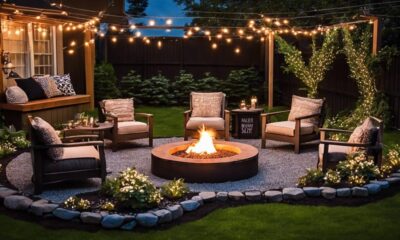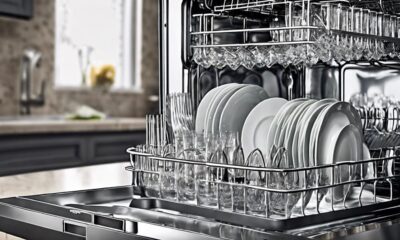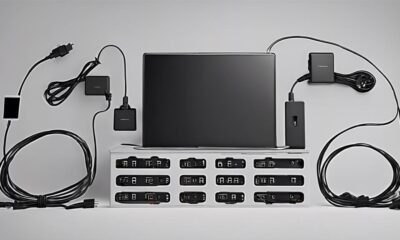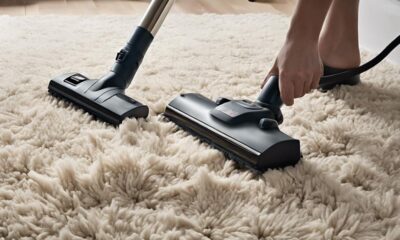Decor
How to Get Algae off Aquarium Decor
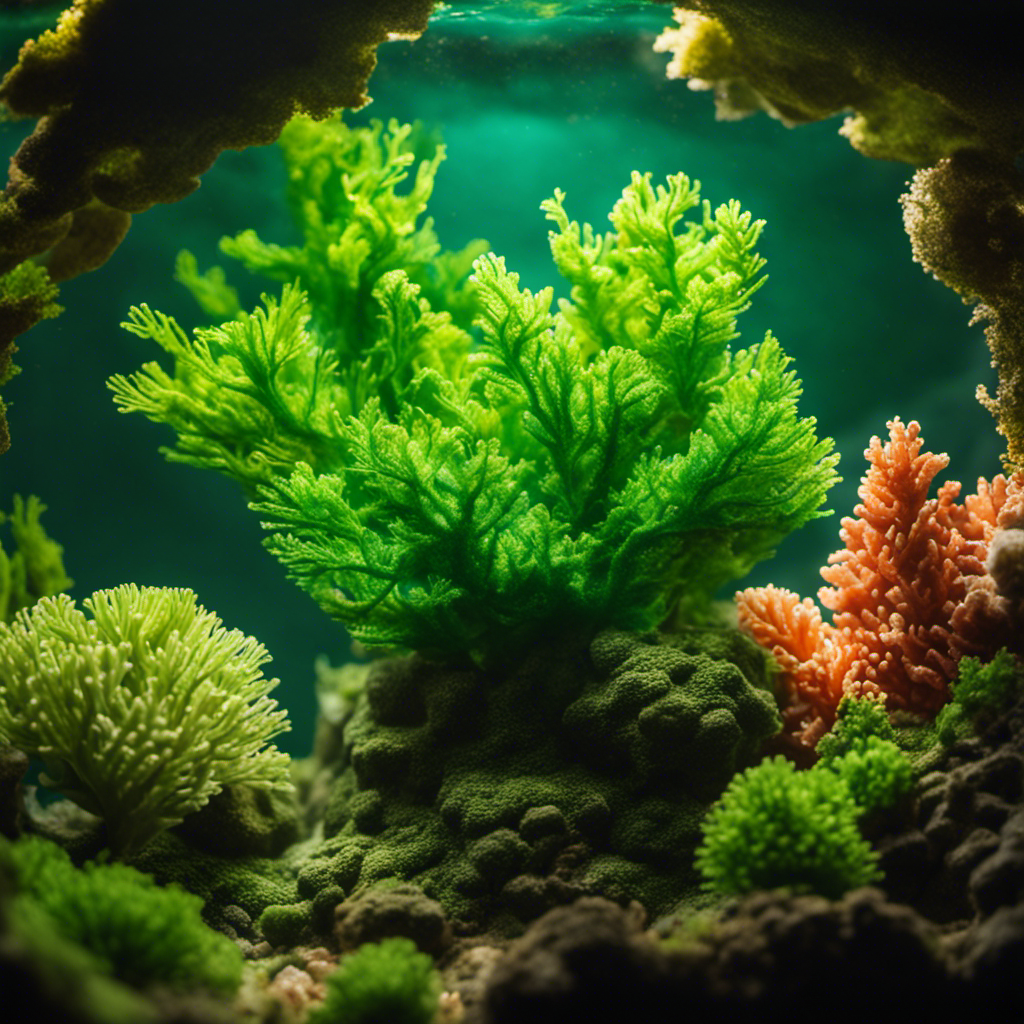
Hey there, fellow aquarium enthusiasts! Ever found yourself struggling with unsightly algae growth on your beloved aquarium decor? Well, fear not! I’m here to share some tried and true methods for getting rid of that pesky algae and restoring the beauty of your underwater oasis.
In this article, we’ll dive into the types of algae that commonly develop on aquarium decor, the proper tools and supplies you’ll need for effective cleaning, and tips for preventing future algae growth.
Get ready to bring back the sparkle to your aquatic haven!
Key Takeaways
- Understanding the types of algae that commonly develop on aquarium decor is important for determining the appropriate course of action.
- Prevention of algae growth through proper maintenance and nutrient control is essential.
- Regular cleaning, debris removal, and water changes help prevent the build-up of organic matter, which can contribute to algae growth.
- Algae scrubbers, soft-bristled brushes, algae pads, and hydrogen peroxide are effective tools and supplies for removing and killing algae on aquarium decor.
Understanding Algae Growth in Aquariums
Understanding the growth of algae in aquariums is essential for effectively removing it from decor. Algae, a diverse group of photosynthetic organisms, can thrive in both freshwater and saltwater tanks.
In freshwater tanks, common types of algae include green algae (Chlorophyta), brown algae (Phaeophyta), and blue-green algae (Cyanobacteria). These algae can quickly multiply and coat the surfaces of aquarium decor, making it unsightly and potentially harmful to fish and other aquatic organisms.
On the other hand, saltwater aquariums face a different challenge when it comes to algae control. Here, the focus is primarily on controlling unwanted growth of diatoms, hair algae, and red slime algae.
Types of Algae That Commonly Develop on Aquarium Decor
When it comes to managing algae in aquariums, two key aspects to consider are algae identification and prevention, as well as effective algae removal techniques.
Identifying the specific type of algae that is present in your aquarium is crucial in determining the most appropriate course of action.
Additionally, preventing algae growth through proper aquarium maintenance and control of nutrient levels is essential for long-term algae management.
Algae Identification and Prevention
To prevent algae growth in your aquarium, it’s important to regularly clean and maintain the decor. Algae can quickly take over the tank, causing an unsightly appearance and potentially harming the fish and plants. Here are some key factors to consider when it comes to algae control methods and common causes of algae growth:
-
Light: Excessive light exposure can fuel algae growth. Be sure to provide appropriate lighting for your aquarium and avoid leaving the lights on for extended periods.
-
Nutrients: Algae thrive on excess nutrients in the water, such as nitrates and phosphates. Monitor and control nutrient levels through regular water testing and proper filtration.
-
Water quality: Maintaining proper water parameters, including temperature, pH, and oxygen levels, is crucial for preventing algae growth.
-
Overfeeding: Excess food in the tank can contribute to algae growth. Feed your fish only the amount they can consume within a few minutes.
-
Lack of maintenance: Regularly clean the tank, remove debris, and perform water changes to prevent the build-up of organic matter that can promote algae growth.
By implementing these algae control methods and addressing common causes of algae growth, you can maintain a clean and healthy aquarium environment.
Now, let’s explore effective algae removal techniques.
Effective Algae Removal Techniques
One effective way to remove algae from your aquarium is by using an algae scrubber or scraper to gently scrub the glass surfaces. Algae scrubbers are specifically designed to target and remove algae from the glass, rocks, and other decor in your aquarium.
By using a scrubber or scraper, you can physically remove the algae without the need for harmful chemicals or treatments. This method is both effective and environmentally friendly, providing a natural algae control solution for your aquarium.
However, it is important to note that while algae scrubbers are effective, they may not completely eliminate all algae growth. For more stubborn algae, you may need to explore other natural algae remedies or consider using proper cleaning tools and supplies for algae removal, which we will discuss in the next section.
Proper Cleaning Tools and Supplies for Algae Removal
You can use a soft-bristled brush and an algae scraper to remove algae from your aquarium decor. These cleaning techniques are highly effective in getting rid of stubborn algae growth. To ensure a successful algae removal process, here are some recommended products and tools to have on hand:
- Algae scraper: A specialized tool designed to easily scrape off algae from glass or acrylic surfaces.
- Soft-bristled brush: Ideal for gently scrubbing away algae from delicate decorations without causing damage.
- Algae pad: A convenient option for quickly wiping away algae from surfaces.
- Hydrogen peroxide: A chemical solution that can be used to spot treat and kill algae growth.
- Magnetic algae cleaner: Consisting of an outer magnet and an inner scrubber, it allows for easy maneuvering and cleaning of algae-covered surfaces.
With these cleaning tools and supplies, you will be well-equipped to tackle algae on your aquarium decor effectively. Now, let’s move on to preparing the aquarium for algae cleaning without causing any harm to the inhabitants.
Preparing the Aquarium for Algae Cleaning
When it comes to effectively cleaning algae from an aquarium, there are several methods to consider. From scrubbing the tank walls to using chemical treatments, each approach has its own advantages and disadvantages.
Additionally, preventing future algae growth is essential in maintaining a healthy and visually appealing aquarium. This can be achieved through proper maintenance, water parameters, and light control.
Effective Cleaning Methods
To effectively clean algae off aquarium decor, it’s important to regularly scrub and rinse the items using a soft brush or sponge. This will ensure that any accumulated algae is removed without damaging the decor. Here are some safe cleaning methods and natural algae removal techniques that can be used:
-
Use a mixture of vinegar and water to create a cleaning solution. Vinegar is a natural disinfectant and can help break down algae.
-
Consider using a magnetic algae cleaner, which allows you to clean the decor without having to remove it from the tank.
-
Introduce algae-eating fish or snails into your aquarium. They will help keep the algae population under control.
-
Avoid using harsh chemicals or abrasive materials, as they can harm your aquatic pets and damage the decor.
-
Maintain proper water parameters, such as temperature and pH levels, to create an environment less conducive to algae growth.
By following these cleaning methods, you can effectively remove algae from your aquarium decor while ensuring the safety and well-being of your aquatic pets.
Transitioning into preventing future algae growth, it’s important to implement preventive measures to maintain a clean and healthy aquarium.
Preventing Future Algae Growth
One effective way to prevent future algae growth in your aquarium is by maintaining proper water parameters and regularly checking the temperature and pH levels. Algae growth is typically fueled by excess nutrients, so it is important to limit the availability of these nutrients in the water. This can be achieved by avoiding overfeeding, performing regular water changes, and using a high-quality filtration system. Additionally, providing adequate lighting and avoiding direct sunlight can help prevent algae growth. It is also beneficial to introduce algae-eating fish or invertebrates into your aquarium, as they can help control algae by consuming it. By following these algae control methods and maintaining optimal water conditions, you can significantly reduce the risk of algae problems in your aquarium.
| Water Parameters | Optimal Range |
|---|---|
| Temperature | 76-82°F |
| pH Level | 6.5-7.5 |
| Nitrate Level | <20 ppm |
| Phosphate Level | <0.2 ppm |
| Lighting Duration | 8-10 hours |
In order to maintain a healthy aquarium and prevent future algae growth, it is important to regularly monitor and adjust these water parameters as needed. By doing so, you can create an environment that is less conducive to algae growth and maintain a visually appealing and thriving aquarium. In the next section, we will explore safe and effective methods for removing algae from decor.
Safe and Effective Methods for Removing Algae From Decor
You can safely and effectively remove algae from your aquarium decor using these methods:
- Manual Scrubbing: Gently scrub the affected areas with a soft brush or sponge to physically remove the algae.
- Algae Scrapers: Utilize specialized algae scrapers to target and scrape off algae from the decor surfaces.
- Chemical Treatments: Use algae-specific chemical treatments that are safe for your fish and plants, following the instructions carefully.
- Natural Remedies: Employ natural remedies such as adding algae-eating fish, introducing snails or shrimp, or using hydrogen peroxide in controlled amounts.
- UV Sterilizers: Install UV sterilizers in your aquarium to kill algae and prevent future growth.
These safe and effective techniques will help you restore the beauty of your aquarium decor. By implementing these methods, you can remove algae effectively without harming your aquatic ecosystem.
Now, let’s explore some tips for preventing algae growth on your aquarium decor.
Tips for Preventing Algae Growth on Aquarium Decor
Installing a UV sterilizer in your tank can help prevent algae growth on your aquarium decor. Algae blooms can be a common problem in aquariums. They can quickly take over your decor, making it unsightly and potentially harmful to your fish. UV sterilizers work by using ultraviolet light to kill algae cells and prevent them from reproducing. This helps to keep your tank water clear and your decor algae-free.
In addition to using a UV sterilizer, there are also other natural methods for algae control. These include maintaining proper water parameters, providing adequate filtration, and reducing nutrient levels in the tank. By implementing these preventative measures, you can effectively minimize the risk of algae growth on your aquarium decor.
Now, let’s move on to troubleshooting algae issues in the aquarium.
Troubleshooting Algae Issues in the Aquarium
To troubleshoot algae issues in your aquarium, start by examining the water parameters and adjusting them if necessary. Proper water parameters are crucial for maintaining a healthy aquatic environment and controlling algae growth. Here are some key steps to troubleshoot algae issues:
- Test the water for pH, ammonia, nitrite, and nitrate levels.
- Ensure that the water temperature is within the appropriate range for your fish and plants.
- Check the lighting duration and intensity. Algae thrive in excessive light, so consider reducing the lighting period or using a dimmer.
- Evaluate the nutrient levels in the water, particularly phosphates and nitrates. Excessive nutrients can fuel algae growth.
- Regularly clean the aquarium, including the substrate, filters, and decorations, to remove any accumulated debris that can contribute to algae growth.
By addressing these factors, you can effectively troubleshoot algae issues in your aquarium and create a healthier environment for your aquatic pets.
Now, let’s explore the role of water parameters in algae control.
The Role of Water Parameters in Algae Control
Examining and adjusting water parameters is essential for controlling algae growth in your aquarium. Maintaining proper water quality is crucial in preventing the proliferation of algae. Algae control strategies rely heavily on maintaining optimal water conditions.
Factors such as pH, temperature, and nutrient levels should be carefully monitored and regulated. A pH level between 7.0 and 8.0 is ideal for preventing excessive algae growth. Additionally, maintaining a stable temperature between 72°F and 78°F can help control algae population. Nutrient levels, specifically nitrates and phosphates, should be kept low to discourage algae growth.
Regular water testing and appropriate adjustments are necessary to ensure a healthy environment for your aquatic pets. By carefully managing water parameters, you can create an environment that is less favorable for algae to thrive, leading to a clean and algae-free aquarium.
Maintaining a Clean and Algae-Free Aquarium Environment
Keeping up with regular water changes and cleaning the filter will help ensure a clean and algae-free environment in your aquarium. Algae can quickly take over an aquarium, making it unsightly and potentially harmful to the fish and other aquatic life.
To effectively control algae growth, consider the following methods and remedies:
-
Introduce algae-eating fish, such as Siamese algae eaters or Otocinclus catfish, to help keep algae under control.
-
Use a UV sterilizer, which utilizes ultraviolet light to kill algae cells and prevent their growth.
-
Adjust the lighting in your aquarium to reduce the amount of light reaching the algae, as they thrive in bright conditions.
-
Add aquatic plants, such as Anubias or Java Moss, to absorb excess nutrients that algae feed on.
-
Utilize natural remedies like adding liquid carbon or hydrogen peroxide in moderation to inhibit algae growth.
Frequently Asked Questions
How Often Should I Clean My Aquarium Decor to Prevent Algae Growth?
I clean my aquarium decor regularly to prevent algae growth. It’s important to remove any excess algae and debris from the decor. Regular water changes and proper filtration are also key in preventing algae growth.
Can I Use Bleach to Clean My Aquarium Decor?
Yes, bleach can be used to clean aquarium decor, but it’s important to dilute it properly and rinse thoroughly. However, if you prefer a natural alternative, a vinegar solution can also effectively remove algae.
What Are Some Natural Methods for Removing Algae From Aquarium Decor?
To get algae off aquarium decor, you can use natural methods instead of chemical cleaners. DIY algae scrubbers, like a toothbrush or sponge, can effectively remove algae without harming the fish or plants in the tank.
Is It Safe to Use Algae-Eating Fish or Invertebrates to Control Algae Growth?
Is it safe to use algae-eating fish or invertebrates to control algae growth? Using them as a natural method has pros and cons. Alternatively, there are chemical and non-chemical methods to prevent algae growth in aquariums, each with their own advantages and disadvantages.
How Do I Know if the Algae in My Aquarium Is Harmful to My Fish?
To determine if algae in my aquarium is harmful to my fish, I observe any changes in their behavior, appetite, or appearance. If I notice any negative effects, I can use effective algae control methods to keep my fish safe.
Can the Methods Used to Fold Towels for Bathroom Decor Also Help in Removing Algae from Aquarium Decor?
When it comes to removing algae from aquarium decor, the methods used for folding towels for bathroom decor may not be directly applicable. However, maintaining a clean environment by regularly wiping surfaces and keeping the water quality in check can help prevent algae growth in aquariums.
Conclusion
In conclusion, it is crucial for the health and well-being of your aquatic pets to maintain a clean and algae-free aquarium environment. Just as a gardener tends to their plants, we must tend to our aquariums to ensure a harmonious ecosystem.
By understanding the types of algae that commonly develop on aquarium decor and utilizing proper cleaning tools and supplies, we can effectively remove algae and prevent its regrowth.
Remember, like a vigilant guardian, we must consistently monitor water parameters and troubleshoot any algae issues that arise.
With dedication and knowledge, we can cultivate a thriving underwater paradise.
- About the Author
- Latest Posts
Introducing Ron, the home decor aficionado at ByRetreat, whose passion for creating beautiful and inviting spaces is at the heart of his work. With his deep knowledge of home decor and his innate sense of style, Ron brings a wealth of expertise and a keen eye for detail to the ByRetreat team.
Ron’s love for home decor goes beyond aesthetics; he understands that our surroundings play a significant role in our overall well-being and productivity. With this in mind, Ron is dedicated to transforming remote workspaces into havens of comfort, functionality, and beauty.
Southeast Asia Decor
3 Best Feng Shui Color Schemes for Interiors
Perfect your home’s energy flow with the 3 best Feng Shui color schemes for interiors; discover how colors can transform your space into a harmonious haven.

To create harmonious interiors, consider three Feng Shui color schemes. First, warm colors like reds and oranges energize spaces, making them perfect for social areas. Second, cool colors such as blue and green promote calmness and enhance focus, ideal for relaxation spaces. Finally, balanced combinations blending cool and warm tones foster tranquility while stimulating creativity, helping maintain emotional stability. By thoughtfully selecting these color schemes, you can cultivate an inviting atmosphere that encourages positive energy flow. Keep exploring to discover more tips on enhancing your home's Feng Shui through color!
Key Takeaways
- Warm Color Scheme: Incorporate reds, oranges, and yellows in active spaces to energize and stimulate social interactions while promoting connection and creativity.
- Cool Color Scheme: Utilize blues, greens, and purples in serene areas to create tranquility, enhance concentration, and foster emotional stability.
- Balanced Combinations: Pair warm earth tones with cool colors to enhance tranquility while maintaining creative energy and harmony in the space.
- Neutral Accents: Mix neutral colors with vibrant accents to maintain visual interest without causing sensory overload, promoting a balanced atmosphere.
- Layering Techniques: Use varying shades and tones to create depth and harmony, reflecting light and encouraging a positive energy flow throughout the interiors.
Warm Color Schemes for Energy

When it comes to your home's energy, warm color schemes like reds, oranges, and yellows can make a significant impact. These warm colors not only energize your spaces but also stimulate social interactions, making them perfect for active areas like your living room. By incorporating these shades, you can create a harmonious environment that fosters connection and creativity.
Additionally, consider adding Indonesian decorative pillows in vibrant colors and intricate patterns to enhance the warmth and character of the room.
In Feng Shui, red is an auspicious color symbolizing luck, wealth, and prosperity. Use it sparingly to maintain balance without overwhelming the space. Pair it with vibrant oranges and yellows to enhance liveliness and brightness, promoting uplifting energy throughout your home.
These colors embody the fire element, providing a sense of warmth and comfort that nurtures relationships and gatherings.
A well-thought-out interior design can blend warm colors with cooler tones when necessary, preventing sensory overload while still maintaining that invigorating atmosphere. By carefully selecting warm colors, you can establish a space that radiates positive energy, ensuring your living room feels alive and welcoming.
Ultimately, this thoughtful approach helps you achieve stability and nurturing in your home, creating a vibrant energy that enriches your everyday life.
Cool Color Schemes for Calm

Cool color schemes, featuring shades of blue, green, and purple, can transform your space into a serene retreat. By incorporating these colors, you invite calmness and serenity into your home, making them perfect for bedrooms and meditation areas.
Light to mid-tone blues represent the water element in feng shui, promoting tranquility and aiding concentration, while darker blues can enhance wisdom and career success. Additionally, elements of traditional Indonesian style home decor can complement these colors, utilizing natural materials to further enhance the calming atmosphere.
Greens, associated with the wood element, symbolize growth and healing. Using these shades fosters a sense of balance and well-being in your environment.
For a more spiritual touch, purples are linked to spiritual energy, enhancing relaxation and minimizing stress, which is ideal for areas dedicated to reflection and calmness.
When you integrate these cool colors into your interiors, you create a peaceful atmosphere that supports mental clarity and emotional stability. This aligns beautifully with the principles of harmonious living in feng shui.
Balanced Color Combinations for Harmony
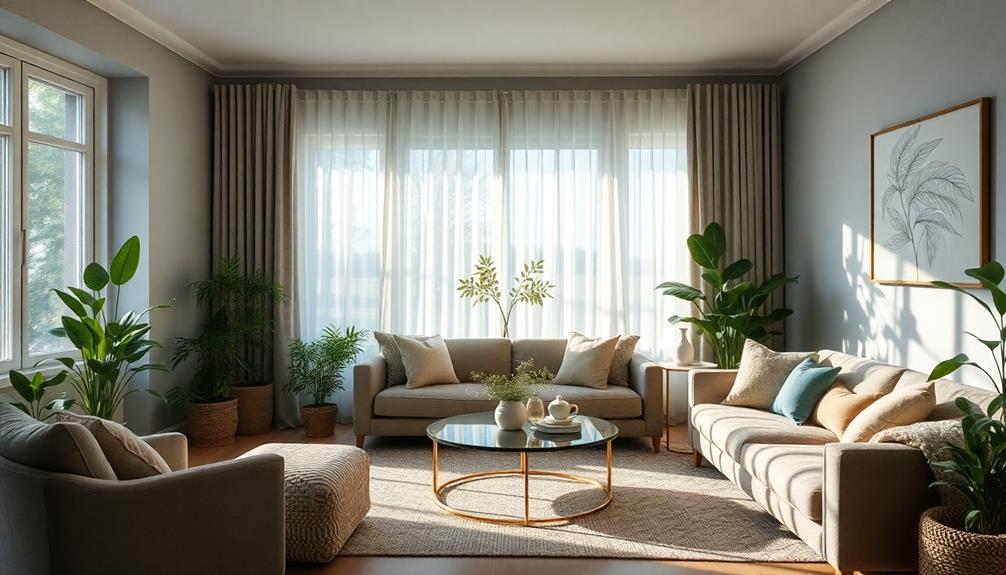
Incorporating balanced color combinations into your interiors creates a harmonious environment that fosters well-being. By utilizing the five elements of feng shui—earth, metal, water, wood, and fire—you can promote harmonious energy flows in your home. For instance, pairing warm earth tones with cool blues or greens enhances tranquility while stimulating creativity.
You can also mix neutral colors like beige or gray with vibrant accents such as red or orange to maintain visual interest without overwhelming the senses. Color theory can guide you in selecting the best colors that evoke desired emotional responses, whether calming or energizing.
Here's a visual representation of some effective balanced color combinations:
| Element | Color Combination |
|---|---|
| Earth Element | Warm earth tones + Cool blues |
| Water Energy | Soft blues + Green accents |
| Fire Energy | Neutrals + Vibrant red/orange |
Thoughtful layering of colors creates depth and harmony, with lighter shades reflecting light and darker hues adding richness. This layering fosters a nurturing atmosphere, ensuring that the energy in your home feels balanced and inviting.
Frequently Asked Questions
What Colors Should Be Avoided in Feng Shui?
You should avoid excessive black, overly bright colors, too much red, and dark shades in small spaces. Also, steer clear of an abundance of white, as it can feel sterile and lifeless in your environment.
Which Colour Is Lucky for House Interior?
Imagine a vibrant sunset filling your home with warmth. For luck in your interiors, embrace red's passion, yellow's cheer, or green's healing touch. Each color invites prosperity, nurturing, and growth, transforming your space into a sanctuary.
What Is the Best Color to Paint in Feng Shui?
To choose the best color in Feng Shui, consider each room's purpose. Serene blues for bedrooms, vibrant reds for living spaces, and soft hues for bathrooms can all enhance energy and create harmony in your home.
What Is the Power Color in Feng Shui?
Imagine your home office glowing with red accents; it energizes creativity and attracts prosperity. In Feng Shui, red's your power color, symbolizing luck and wealth, but balance it with softer hues to maintain harmony.
Conclusion
By now, you've probably noticed how colors impact your mood and energy levels in your space. Isn't it fascinating how a splash of warm hues can energize your mornings, while cool tones create a serene evening retreat? Just imagine blending those balanced combinations for ultimate harmony. As you experiment with these feng shui color schemes, you might stumble upon a perfect palette that transforms your home into a sanctuary, making every moment feel just right.
- About the Author
- Latest Posts
Introducing Ron, the home decor aficionado at ByRetreat, whose passion for creating beautiful and inviting spaces is at the heart of his work. With his deep knowledge of home decor and his innate sense of style, Ron brings a wealth of expertise and a keen eye for detail to the ByRetreat team.
Ron’s love for home decor goes beyond aesthetics; he understands that our surroundings play a significant role in our overall well-being and productivity. With this in mind, Ron is dedicated to transforming remote workspaces into havens of comfort, functionality, and beauty.
Southeast Asia Decor
What Are Ideal Feng Shui Color Schemes?
Navigate the vibrant world of Feng Shui color schemes to discover how specific hues can transform your space into a sanctuary of balance and harmony.
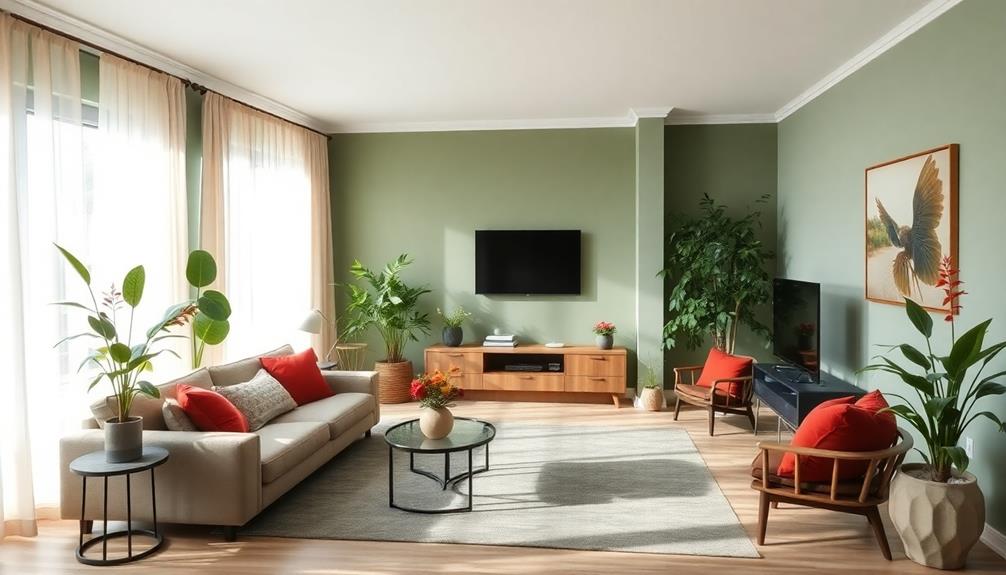
Ideal Feng Shui color schemes help create balance and enhance emotional well-being. Start by associating specific colors with the five elements: use calming blues and blacks for water, vibrant greens for wood, energetic reds for fire, hopeful yellows for earth, and purifying whites for metal. Pair warm and cool colors thoughtfully to maintain harmony. For example, choose soft greens and blues for bedrooms or bright yellows and reds for kitchens. Incorporating seasonal colors will also keep your space aligned with nature. These choices foster positivity and stability. Keep exploring to discover more insights that can transform your environment further.
Key Takeaways
- Ideal Feng Shui color schemes incorporate the five elements: water, wood, fire, earth, and metal, enhancing energy flow and emotional well-being.
- Color combinations should balance warm and cool tones; warm colors energize active areas, while cool colors promote calmness in relaxation spaces.
- Specific element-based pairings include greens and blues for bedrooms (wood & water) and reds and yellows for kitchens (earth & fire).
- Seasonal color adjustments align with nature, using soft greens in spring and vibrant reds in summer to enhance mood and energy.
- Cultural significance of colors varies; understanding these nuances ensures personal connections to color choices in Feng Shui applications.
Understanding Feng Shui Principles
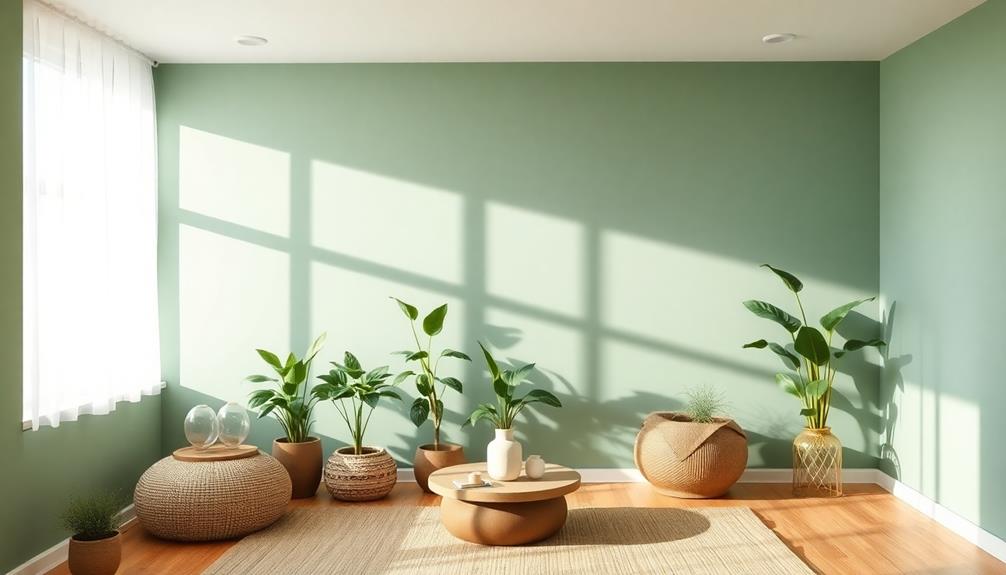
How can understanding feng shui principles transform your living space? By grasping the role of colors and the five elements, you can create an environment that not only looks good but feels good too.
Each color in feng shui corresponds to specific emotions and energies, impacting the overall vibe of your room. Incorporating elements like Indonesian decorative pillows with vibrant colors and intricate patterns can enhance the aesthetic while reflecting cultural heritage.
Finding the right balance between warm and cool colors is essential. Too much fire energy can lead to anxiety, while an overabundance of blue might make your space feel cold and uninviting.
That's where the five elements come into play. Water, wood, fire, earth, and metal each have associated colors that can enhance the desired energy in your home.
For instance, incorporating greens and browns can promote liveliness and grounding, while soft pastels might invite calmness. Understanding these characteristics can guide your color selections, allowing you to promote specific intentions like stability or creativity.
Thoughtful color choices aren't just about aesthetics; they shape your space's emotional and energetic qualities, fostering harmony and well-being.
Color Associations and Their Effects
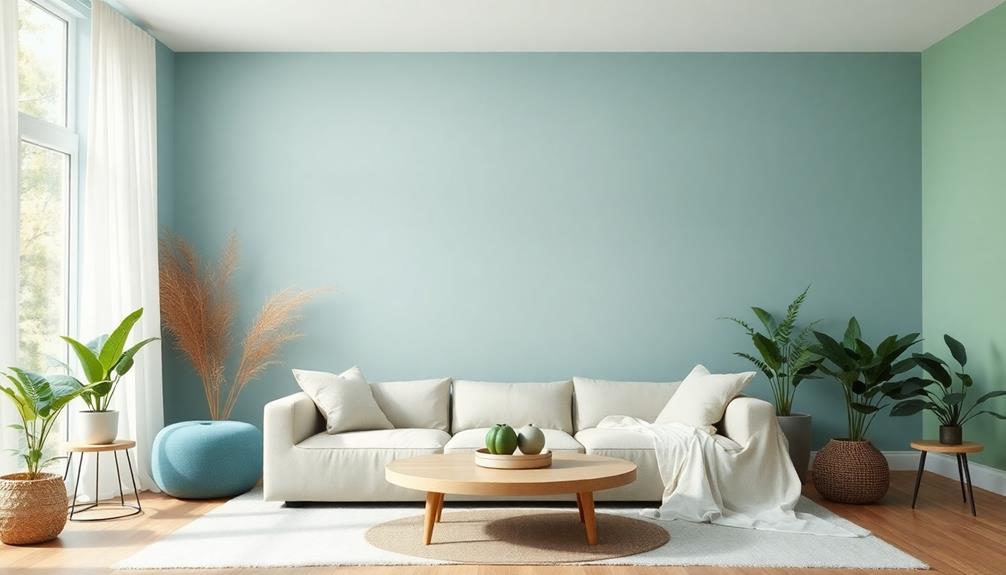
Exploring color associations in feng shui reveals how specific hues can greatly influence your mood and energy levels. For instance, blue and black, representing the Water element, calm the mind and aid concentration. These colors are perfect for tranquil spaces like bedrooms and bathrooms, helping you create a harmonious atmosphere.
Incorporating elements of traditional Indonesian style home decor can enhance this calming effect by utilizing natural materials that promote relaxation.
Green, associated with Wood, symbolizes growth and renewal, motivating change and encouraging creativity. It's an excellent choice for offices or studios where you need inspiration.
On the other hand, red represents the Fire element and increases heart rate, promoting passion and alleviating depression. This vibrant hue is ideal for lively areas like living rooms and kitchens, where social interaction thrives.
Yellow, linked to Earth, infuses hope and clarity, stabilizing environments. It's great for dining rooms or studies, where mental focus and positivity are desired.
Ultimately, white and metallic colors support concentration and represent purity, making them the best feng shui choice for workspaces and libraries.
Recommended Color Combinations
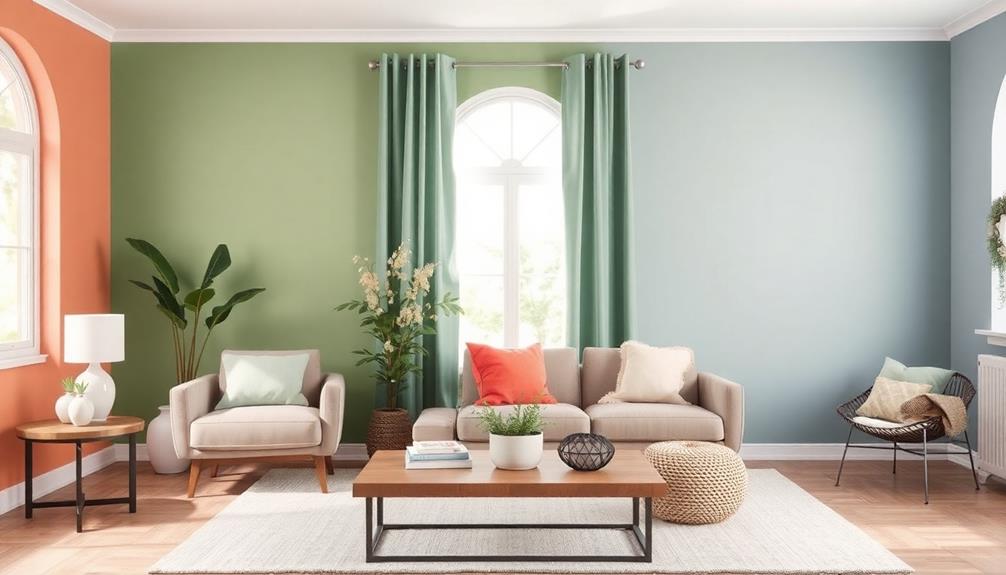
When choosing colors for your space, think about how warm and cool tones can harmonize to create the right vibe.
Incorporating natural materials and colors can further enhance the overall atmosphere of your home.
Element-based color pairings can enhance the natural energy of each room, making it feel more inviting or productive.
Harmonizing Warm and Cool
Harmonizing warm and cool colors can transform your space into a balanced haven. By applying color theory, you can create an inviting atmosphere while promoting tranquility.
For instance, combining warm colors like yellow and red in active spaces such as living rooms and kitchens can energize the environment, making it vibrant and welcoming. Incorporating unique decor pieces from local artisans can enhance this effect, as seen in the offerings of Balinese furniture shops.
On the other hand, cool colors like blue and green are perfect for relaxing areas like bedrooms and bathrooms, fostering a sense of calmness. If you're looking to blend these two spectrums, consider using turquoise. This color merges the qualities of wood and water, promoting growth while maintaining a soothing vibe, making it ideal for creative spaces like offices.
In laundry rooms, soft warm colors paired with muted blues and greens can stabilize water energy, creating a visually appealing and serene atmosphere.
Balancing these color combinations based on room functionality not only enhances the aesthetic but also supports the intended purpose of each space, improving overall energy flow and emotional responses. Embrace this harmonious blend to elevate your home's ambiance.
Element-Based Color Pairings
How can you elevate your space's energy through color? By understanding element-based color pairings in Feng Shui, you can create a harmonious atmosphere that reflects your intentions. Here are some recommended combinations that align with the five elements:
| Element Pair | Color Choice | Ideal Space |
|---|---|---|
| Earth & Fire | Beige, Soft Yellow, Red, Orange | Living Spaces, Kitchens |
| Wood & Water | Greens, Blues | Bedrooms, Bathrooms |
| Metal & Earth | Whites, Taupe, Metallics | Workspaces |
| Fire & Wood | Reds, Fiery Pinks, Greens | Creative Spaces |
| Water & Metal | Deep Blues, Blacks, Metallics | Meditation Rooms |
Each color choice influences the energy in your environment. For instance, combining warm earth tones with fiery reds creates a balanced atmosphere, while greens and blues promote tranquility. Similarly, metallics paired with warm earth shades enhance clarity in workspaces. By thoughtfully selecting your Feng Shui colors based on these element colors, you can foster an environment that supports your life goals and enhances your overall well-being.
Enhancing Room Functions
To enhance the functionality of each room, selecting the right color combinations is essential. The colors you choose can greatly affect the mood and purpose of each space.
For instance, incorporating elements from traditional Indonesian housing can inspire unique color palettes that resonate with cultural significance. Here are some recommended color schemes to contemplate:
- Living Room: Combine warm neutrals like greige with vibrant yellows and reds. This mix promotes social interactions while maintaining a cozy atmosphere.
- Bedroom: Utilize soft greens and blues to create a serene environment conducive to relaxation and restful sleep.
- Kitchen: Incorporate fire element colors such as sunny yellows and reds, balanced with earthy tones. This combination stimulates appetite and sparks creativity during meal preparation.
- Bathroom: Opt for soft whites and muted blues to minimize excessive water energy. Adding warm accents creates a harmonious balance and enhances tranquility.
Each of these color schemes serves a specific function, helping you design spaces that not only look good but also feel right.
Room-Specific Color Guidelines

Choosing the right colors for each room can greatly impact the energy flow and overall ambiance of your home.
In your living space, you'll want to blend yin colors like soft blues or greens for relaxation with yang colors such as vibrant yellows or reds to energize the area and encourage social interactions. Incorporating elements of traditional artistry through decor masks can also enhance the cultural richness of your space.
For your bedroom, calming colors like lavender or soft blue enhance tranquility and promote restful sleep, while earthy tones ground the energy.
In the bathroom, soft warm colors like pale peach or beige balance the excessive water energy, creating a calming atmosphere. Add warm accents to stabilize the energy flow.
For your laundry room, opt for light colors like muted blues or soft grays that foster a visually appealing, calming environment, complemented by warm color accents for added comfort.
In the kitchen, utilize warm colors like sunny yellow or inviting orange to stimulate appetite and promote social interactions, balanced with neutral tones for harmony.
Personal Preferences in Color Choices
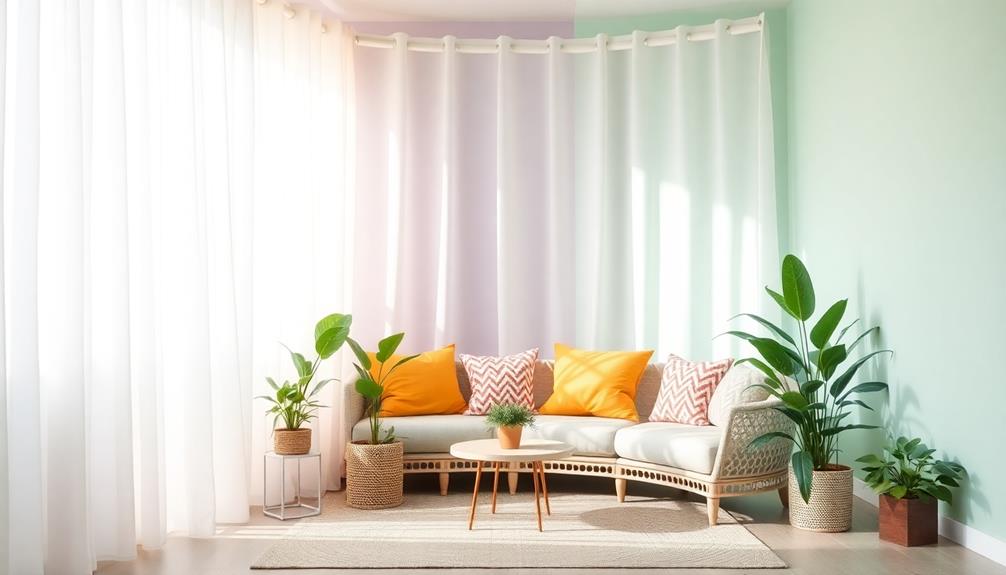
When it comes to choosing colors for your space, your emotional connection plays an essential role.
Cultural significance can also influence your preferences, making certain shades resonate more deeply.
For instance, incorporating elements like a Face Indonesian Decor Mask can enrich your color scheme with vibrant designs and cultural heritage.
Emotional Connection to Colors
Colors can profoundly impact your emotions and overall well-being, making personal preferences a crucial element in creating a harmonious space.
When you choose colors that resonate with you, you enhance the positive chi in your environment. For example, incorporating elements like Indonesian decor masks can add a cultural touch that complements your color scheme.
The emotional connection to colors can greatly influence how you feel daily. Here are four ways to reflect on your emotional connection to colors:
- Warmth from Reds: Reds can evoke feelings of passion and energy, perfect for spaces where you want to stimulate activity.
- Calmness from Blues: Blues promote tranquility and relaxation, ideal for bedrooms or meditation areas.
- Joy from Yellows: Yellows bring cheerfulness and optimism, making them great for kitchens or workspaces.
- Balance from Greens: Greens symbolize growth and harmony, creating a rejuvenating atmosphere in any room.
Cultural Color Significance
Incorporating cultural color significance into your space can enrich your personal color choices and create a deeper connection to your environment. The cultural significance of colors varies widely; for instance, red represents luck and prosperity in Chinese culture, while in the West, it often symbolizes passion or danger.
Similarly, in Indonesian culture, vibrant colors like red and gold are often used in celebrations, enhancing the festive ambiance and reflecting cultural motifs in decorations, such as those seen in Indonesian Wedding Decor. Your personal preferences in color choices are shaped by your unique experiences and memories, leading to distinct emotional responses to different hues.
Understanding how certain colors evoke feelings based on cultural context can help you choose wisely. For example, white often symbolizes purity and weddings in Western cultures, but in some Eastern societies, it's associated with mourning. By recognizing these cultural nuances, you can enhance your feng shui practices, aligning your personal preferences with the intended energetic qualities of colors.
Ultimately, your comfort and happiness in color choice are essential. When you select colors that resonate positively with you, it elevates the overall energy and atmosphere of your space.
Embracing the cultural significance of colors not only personalizes your environment but also deepens your emotional connection to it.
Personal Style Integration
Integrating your personal style into color choices is vital for creating a space that feels truly yours. When you incorporate your personal preferences, you enhance the positive chi in your environment, making it more inviting and comforting.
This approach can be especially effective when considering elements from tropical villa plans that emphasize open spaces and natural light. Here are some tips to help you achieve a harmonious atmosphere:
- Identify Your Favorite Colors: List colors that evoke happiness and comfort for you. This guarantees your space resonates with your emotions.
- Understand Color Meanings: Research how different colors align with feng shui elements, but prioritize what feels right for you.
- Balance and Contrast: Mix bold colors with softer shades to create visual interest while maintaining emotional comfort.
- Personal Inspirations: Draw from personal experiences or memories that inspire you; this could lead to unique color combinations.
Balancing Colors for Harmony
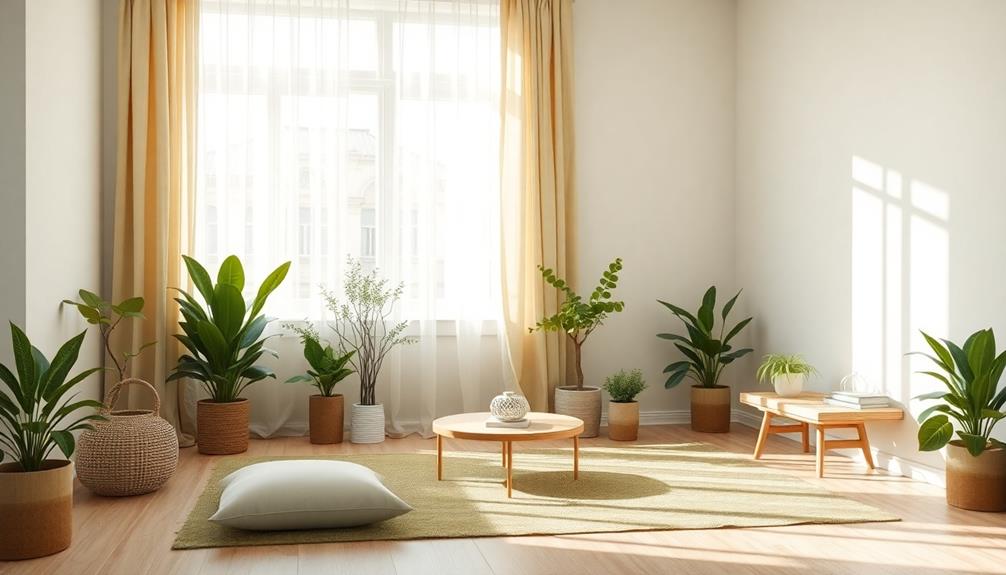
When designing a space, balancing colors is essential for creating a harmonious environment. You want to avoid sensory overload, which can happen when there's too much color, leading to chaos. At the same time, too little color can make a room feel dull.
Incorporating both warm and cool colors is key; warm colors energize spaces like living rooms, while cool colors promote calmness in areas meant for relaxation.
Consider the size of your room as you choose your palette. Larger rooms can handle bolder colors, while smaller spaces benefit from lighter, softer shades. Understanding the purpose of each room also plays a vital role in selecting the best colors. For instance, vibrant tones can stimulate social interaction in living areas, while soothing hues are better for bedrooms.
Utilizing the five feng shui elements—water, wood, fire, earth, and metal—can guide your color choices, promoting balance and enhancing the overall energy of the space.
Seasonal Color Adjustments

You can elevate your space's energy by making seasonal color shifts that align with nature's cycles.
Think about how color psychology affects your mood and pick palettes that reflect the essence of each season.
Seasonal Color Shifts
Seasonal color shifts play an essential role in feng shui, allowing you to harmonize your living space with nature's cycles.
By making seasonal color adjustments, you enhance the energy of your space and promote balance.
Here's how to align your decor with each season:
1. Spring: Embrace soft greens and yellows to evoke renewal and growth, reflecting the wood element.
These colors invite fresh energy and optimism into your home.
2. Summer: Use vibrant reds and oranges to energize your space.
These bright hues stimulate social interactions and embody the fire element, creating a lively atmosphere.
3. Autumn: Incorporate warm earth tones like browns and muted yellows.
These shades provide grounding energy and comfort as the season shifts, helping you feel secure and settled.
4. Winter: Opt for cool colors like blues and grays to create a serene atmosphere.
This aligns with the water element, promoting calmness and introspection during the colder months.
Color Psychology Influence
Color psychology plays an essential role in how seasonal adjustments can transform your space and mood. By aligning your color choices with the natural rhythms of the environment, you can enhance the energy flow and create a more inviting atmosphere.
During colder months, incorporating warm colors like yellows and reds can stimulate vibrant energy, promoting a cozy and uplifting environment. Conversely, in warmer months, cooler colors such as blues and greens help maintain calmness and ease, allowing you to unwind.
Using color wheels can guide your seasonal color adjustments, ensuring they harmonize with feng shui principles. This approach not only creates balance but also prevents stagnation of chi, keeping your living space dynamic and reflective of the changing seasons.
Regularly updating your decor with seasonal colors is vital for maintaining a vibrant atmosphere.
Moreover, being aware of color psychology enables you to choose shades that resonate with your personal emotions, enhancing your overall well-being. By consciously selecting colors that align with the seasons, you can create a harmonious environment that supports your mood and energy throughout the year.
Nature-Inspired Palette Choices
Nature-inspired palettes bring the beauty of the outdoors into your home, fostering a sense of peace and connection to the environment.
By using earthy tones like greens, browns, and soft blues, you create a grounding atmosphere that enhances emotional well-being. Seasonal color adjustments can further elevate this energy, reflecting nature's shifts outside.
Consider these nature-inspired palette choices for each season:
- Spring: Embrace lighter shades like soft greens and pastel blues to symbolize renewal and growth.
- Summer: Incorporate vibrant yellows and rich greens, evoking liveliness and warmth.
- Autumn: Use deeper hues such as burnt oranges and muted browns for a cozy, nurturing feel.
- Winter: Opt for cool blues and gentle grays to create a serene, tranquil space.
These seasonal color adjustments not only refresh your decor but also align the energy of your home with the earth element, promoting harmony and balance year-round.
Feng Shui for Outdoor Spaces

How can you transform your outdoor spaces into a harmonious retreat? By applying feng shui principles, you can create an inviting environment that reflects balance and tranquility.
Start by incorporating the five feng shui elements—water, wood, fire, earth, and metal—through your choice of landscaping and use of color.
Consider adding a water feature painted in calming blues or greens. This not only attracts positive chi but also provides a soothing effect.
Vibrant colors like red flowers or yellow furniture can inject energy and joy into your outdoor spaces, enhancing their overall atmosphere.
Ground your space with earthy tones, such as browns and greens, to connect with nature and promote stability.
Additionally, embrace seasonal changes in your color schemes; warm yellows and reds in fall align with feng shui principles, creating a dynamic and inviting environment throughout the year.
Shopping for Feng Shui Decor
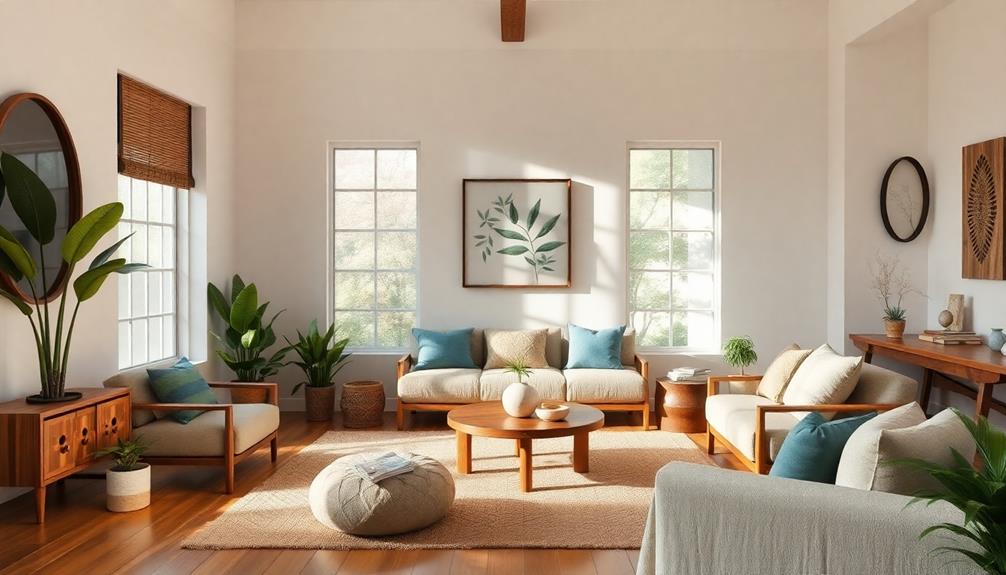
When you're shopping for feng shui decor, focus on items that embody the five elements: water, wood, fire, earth, and metal. Each element plays a crucial role in influencing your space's energy and overall vibe.
To create a harmonious living environment, consider integrating these four types of decor items:
- Water Features: Add a small fountain or artwork depicting water to promote calmness and prosperity.
- Wood Elements: Incorporate wooden furniture or plants to encourage growth and vitality in your space.
- Fire Accents: Use candles or vibrant reds and yellows to energize your living areas and stimulate passion and creativity.
- Earthy Decor: Bring in ceramics or earthy tones to create stability and grounding in your home.
Remember to select colors that align with the purpose of each room; calming blues and greens work well in bedrooms, while lively hues can invigorate living areas.
Also, pay attention to the balance of warm and cool tones to maintain a serene atmosphere.
Simple Ways to Enhance Home Energy
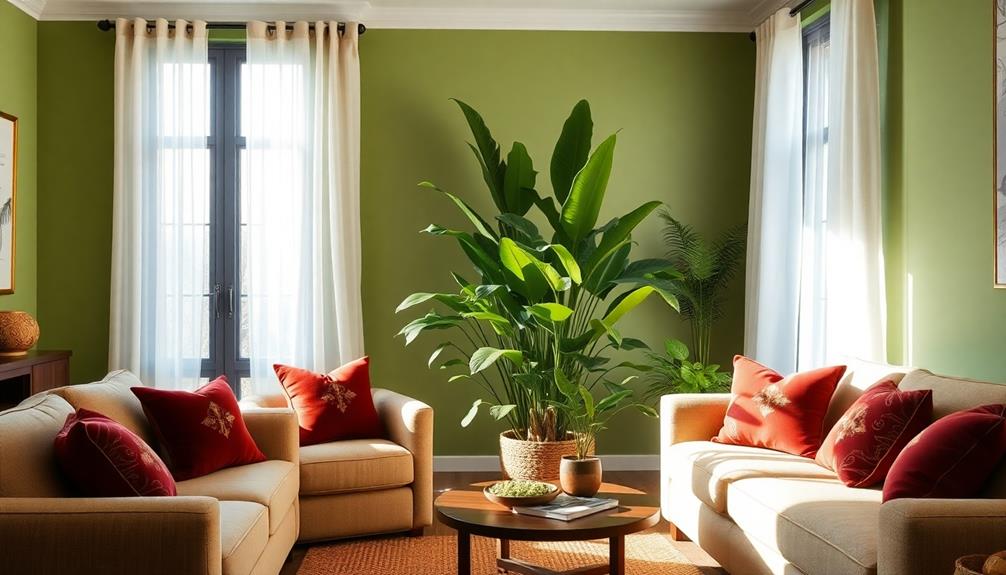
Enhancing the energy in your home can be as simple as making a few intentional changes. Start by incorporating fresh bouquets of flowers; they add vibrant colors that promote positive chi and uplift your atmosphere. These natural elements can greatly enhance the overall energy of your space.
Consider adding small pops of color through decorative pillows or artwork. This technique balances the energy in your home, creating a harmonious environment without overwhelming it.
You can also make daily adjustments, like rearranging furniture or changing table settings, to improve the flow of energy throughout your living areas.
For busy lifestyles, implement easy fixes—swap out light fixtures for colorful options or introduce new accents that refresh a room's energy.
Pay attention to small decorative details, such as color combinations and element representations. These can promote overall well-being and enhance the positive energy in your home.
Frequently Asked Questions
What Are the Best Colors for Feng Shui?
The best colors for feng shui depend on the elements. You'll find calming blues and greens in bedrooms for relaxation, while warm earth tones in living areas create coziness. Choose colors that resonate with you for harmony.
What Is the Power Color in Feng Shui?
In Feng Shui, the power color is red. It symbolizes luck and prosperity, energizing your space. Use it sparingly, balancing with cooler tones to avoid feelings of anxiety, while enhancing creativity and social interactions.
What Is the Color of Success in Feng Shui?
You might think success is just about effort, but in Feng Shui, colors like red and gold symbolize wealth and prosperity. Incorporating green and purple encourages growth and wisdom, creating a vibrant space for your aspirations.
What Color Is Good Luck for a House?
For good luck in your house, consider using red. It's a powerful color that invites positive energy and prosperity. You can incorporate it through accents or decor to enhance the overall atmosphere of your home.
Conclusion
Incorporating ideal feng shui color schemes into your home is like painting a vibrant tapestry of energy and harmony. Each hue carries its own symbolism, from the calming blues of tranquility to the invigorating reds of passion. As you choose colors that resonate with you, you're not just decorating; you're weaving a sanctuary that reflects your spirit. Remember, your space should feel like a warm embrace, inviting peace and positivity into your life with every shade.
- About the Author
- Latest Posts
Introducing Ron, the home decor aficionado at ByRetreat, whose passion for creating beautiful and inviting spaces is at the heart of his work. With his deep knowledge of home decor and his innate sense of style, Ron brings a wealth of expertise and a keen eye for detail to the ByRetreat team.
Ron’s love for home decor goes beyond aesthetics; he understands that our surroundings play a significant role in our overall well-being and productivity. With this in mind, Ron is dedicated to transforming remote workspaces into havens of comfort, functionality, and beauty.
Southeast Asia Decor
5 Tips for Feng Shui Color Harmony in Interiors
Find out how to enhance your home’s energy with Feng Shui color harmony and discover the surprising effects of color on your emotions.
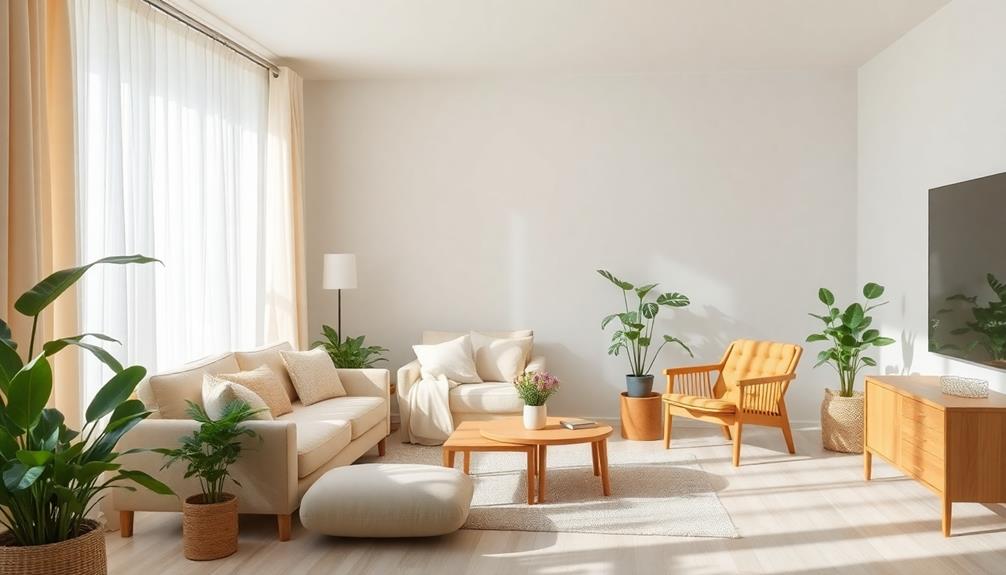
To achieve Feng Shui color harmony, start by embracing the five elements: use green for growth, red for passion, earthy tones for stability, metallics for clarity, and blue or black for tranquility. Understand how colors affect emotions; for instance, warm shades enhance social energy while cool colors promote relaxation. Utilize the Bagua map to target specific life areas, like green in the wealth quadrant. Balance warm and cool tones in different rooms to create an inviting atmosphere. Finally, create a consistent color palette to enhance energy flow. Keep exploring these concepts for even more impactful design insights!
Key Takeaways
- Use colors associated with the five elements—wood, fire, earth, metal, and water—to create a balanced and harmonious environment.
- Incorporate warm colors like red and pink in social areas to enhance passion and interaction, while utilizing cool colors for relaxation spaces.
- Apply the Bagua map to strategically use colors in specific quadrants to promote desired aspects of life, such as love and wealth.
- Maintain a consistent color palette using complementary colors and elemental shades to enhance energy flow and emotional well-being in your home.
- Balance warm and cool tones by mixing accents to create inviting focal points without overwhelming the space.
Embrace the Five Elements
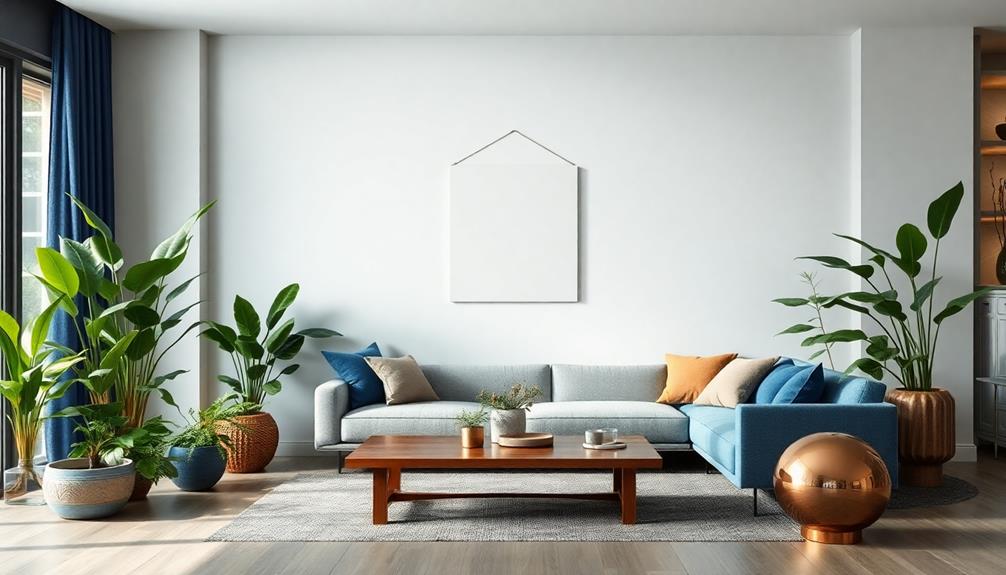
To create a harmonious interior, you should embrace the Five Elements of Feng Shui: wood, fire, earth, metal, and water. Each element corresponds to specific colors that enhance energy flow and foster harmony and balance in your space.
For instance, using green for wood can evoke growth and liveliness, while blue and black for water can create a sense of tranquility and connection to nature. Incorporating vibrant textiles and decorative pillows inspired by Indonesian cultural heritage can further amplify the energy of your space while adding comfort.
Incorporating warm colors like red and pink for fire stimulates passion and creativity, making them ideal for active spaces like living rooms and kitchens. On the other hand, metallic colors like white represent metal, enhancing clarity and productivity—perfect for workspaces and home offices.
To ground your interiors, earthy colors and textures relate to the earth element, providing stability and a soothing atmosphere, which is essential for bedrooms.
Understand Color Associations
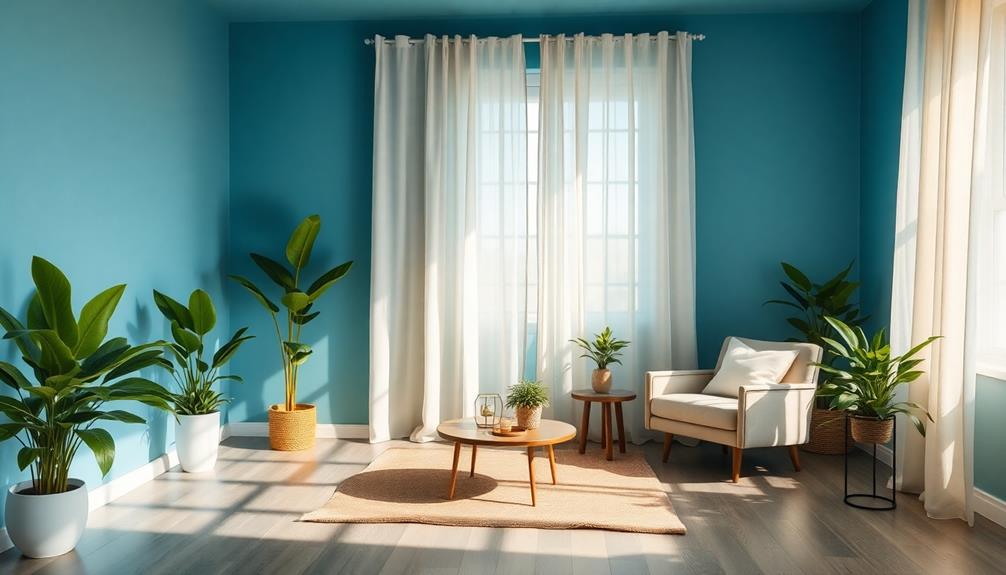
Understanding color associations in Feng Shui is key to harnessing the energy of your space. Each color corresponds to one of the elements of Feng Shui, influencing your emotional responses and promoting harmonious living.
For instance, colors associated with water, like blue and black, create a sense of calm, aid concentration, and lower blood pressure, making them perfect for bedrooms or study areas. Additionally, incorporating elements of traditional artistry into your decor, such as Indonesian masks, can enhance the aesthetic appeal of the space while maintaining the principles of Feng Shui.
Green, representing wood, symbolizes growth and liveliness, encouraging motivation and creativity. This color is ideal for spaces where you want to foster innovation and change.
On the other hand, red, associated with fire, stimulates passion and energy. It's effective in social areas like living rooms, enhancing interactions and making gatherings more vibrant.
Use the Bagua Map
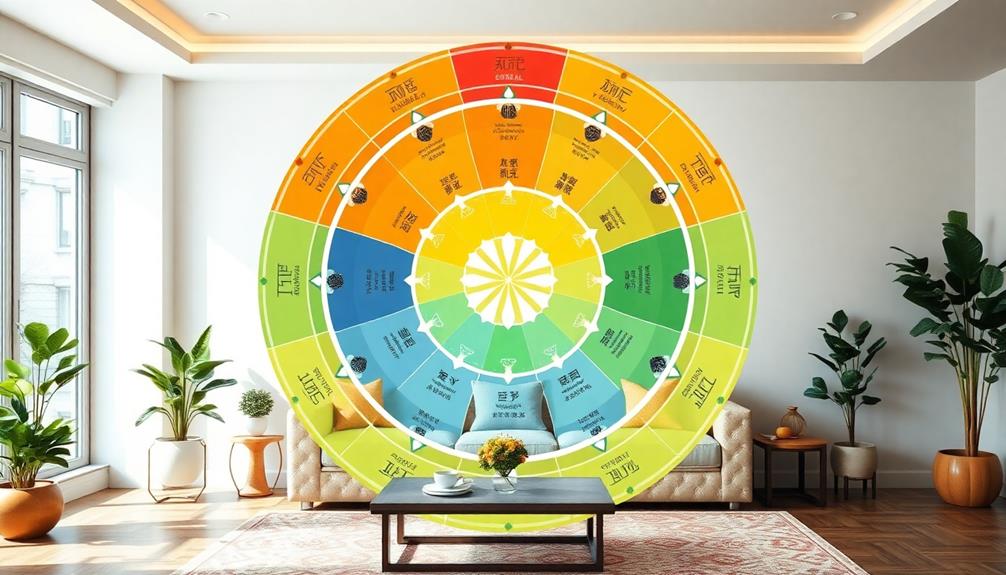
How can the Bagua Map transform your space? This octagonal diagram helps you align your interior design with the principles of Feng Shui, guiding your color choices to enhance various life aspects.
By focusing on specific quadrants, you can create a more harmonious living environment. Incorporating elements of Balinese design can further enhance this harmony, as it emphasizes natural materials and soothing color palettes.
To effectively use the Bagua Map, consider these three key areas:
- Wealth Quadrant: Incorporate colors associated with wood and water, such as green and blue. These specific colors promote prosperity and abundance in your life.
- Love Quadrant: Use warm colors like pink and pairs of decorative objects to foster connection and intimacy. This simple adjustment can greatly enhance your relationships.
- Fame Area: Energize this section with elements of fire, particularly vibrant red items. This boosts your visibility and reputation in both personal and professional spheres.
Balance Warm and Cool Tones
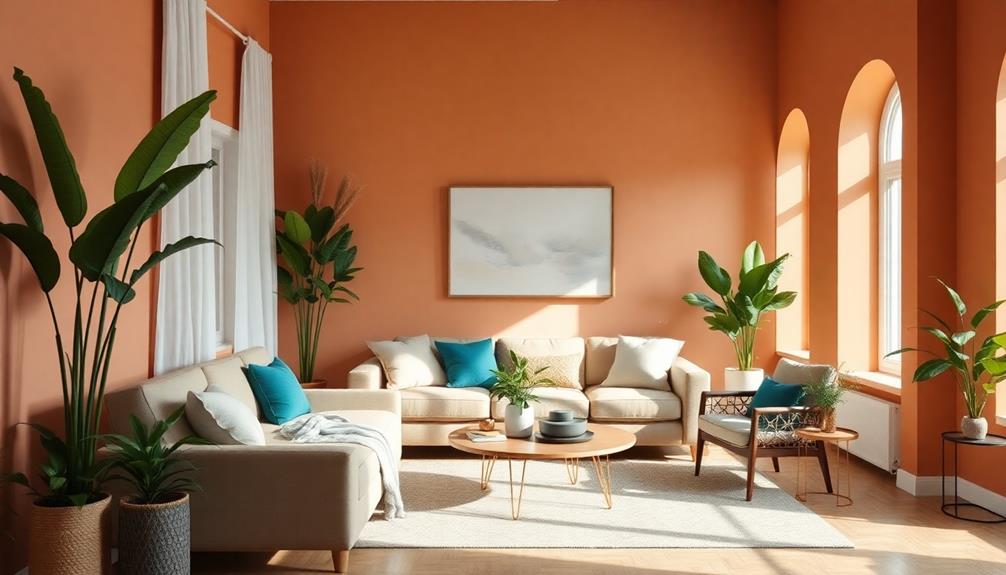
Creating a harmonious environment involves more than just selecting colors based on the Bagua Map; it also requires a mindful balance between warm and cool tones. Too many warm colors like red, orange, and yellow can lead to feelings of anxiety, while excessive cool colors such as blue and green may evoke a sense of coldness.
In traditional Indonesian style home decor, natural materials and a balance of colors are used to enhance the overall ambiance, promoting a relaxed atmosphere.
To create comfort and tranquility, consider the purpose of each room. Warm colors energize spaces, making them perfect for social areas like living rooms, while cool colors promote calmness, ideal for bedrooms and bathrooms. A thoughtful mix can enhance emotional responses; for instance, adding warm accents in a primarily cool room can establish inviting focal points that draw the eye and soften the overall feel.
Strive for balance to guarantee neither warm nor cool colors overwhelm the space. This will maintain a harmonious energy flow, fostering an atmosphere that feels both vibrant and serene.
Create a Consistent Palette
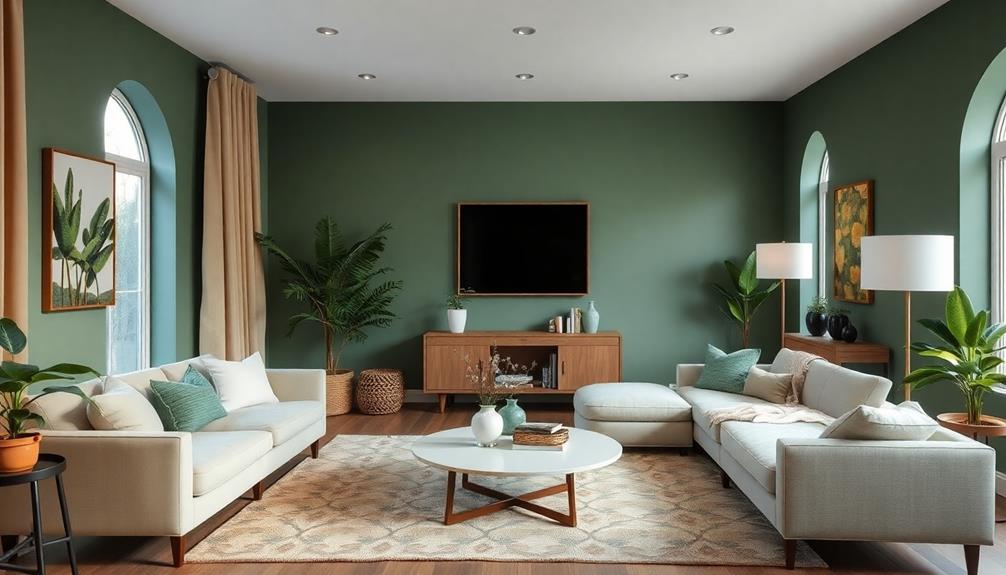
A consistent color palette is essential for fostering harmony and flow in your interior spaces. When you create a cohesive look, you enhance the flow of energy (Chi) throughout your home, promoting balance and emotional well-being.
To elevate your design, consider incorporating elements from luxury tropical design aesthetics that reflect Bali's unique ambiance. Here's how to achieve that:
- Utilize the Color Wheel: Identify complementary colors that resonate with Feng Shui principles. This helps you mix warm colors like reds or yellows with cool colors such as blues or greens, achieving a dynamic yet balanced environment.
- Incorporate Elemental Shades: Choose colors from the same element. For example, using various shades of green can deepen your connection to nature, creating a calming atmosphere.
- Consider Emotional Responses: Select colors based on the intended function of each room. Use calming blues in relaxation areas and energizing reds in social spaces to guarantee your color palette supports the desired vibe.
Frequently Asked Questions
What Is the 3 Color Rule in Interior Design?
The 3 Color Rule in interior design suggests you use three colors: a dominant color for 60%, a supporting color for 30%, and an accent color for 10%, creating balance and visual interest in your space.
What Colors Should Be Avoided in Feng Shui?
You should avoid excessive red, dark blue, bright white, dull colors, and neon shades. These can create feelings of anxiety, heaviness, sterility, stagnation, or chaos, disrupting the peaceful energy flow essential for a harmonious environment.
What Are the Feng Shui Colors for Interior Design?
Ever wondered how colors can transform your space? For interior design, consider blue and black for calmness, green for creativity, red for energy, yellow for warmth, and white for clarity. Choose wisely to enhance your environment!
What Are the Calm Colors for Feng Shui?
For calm colors in feng shui, consider blue and black for tranquility, green for balance, lavender for relaxation, and soft earth tones for grounding. These hues promote peace and harmony in your living spaces.
Conclusion
By incorporating these feng shui color harmony tips, you can transform your space into a balanced oasis. Did you know that studies show color can affect mood and productivity by up to 40%? So, when you harmonize your interior colors, you're not just beautifying your home; you're enhancing your overall well-being. Embrace the power of color and let it guide you toward a more peaceful and energized environment. Happy decorating!
- About the Author
- Latest Posts
Introducing Ron, the home decor aficionado at ByRetreat, whose passion for creating beautiful and inviting spaces is at the heart of his work. With his deep knowledge of home decor and his innate sense of style, Ron brings a wealth of expertise and a keen eye for detail to the ByRetreat team.
Ron’s love for home decor goes beyond aesthetics; he understands that our surroundings play a significant role in our overall well-being and productivity. With this in mind, Ron is dedicated to transforming remote workspaces into havens of comfort, functionality, and beauty.
-

 Retreat3 weeks ago
Retreat3 weeks agoDIY Aromatherapy Diffusers for a Spa-Like Atmosphere at Home
-

 Retreat4 weeks ago
Retreat4 weeks agoThe Profitability of Retreat Centers: A Financial Analysis
-
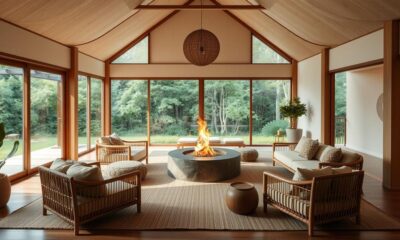
 Retreat2 weeks ago
Retreat2 weeks ago10 Unique Themed Room Ideas for Your Retreat Center
-

 Retreat2 weeks ago
Retreat2 weeks agoThe Business of Retreats: Marketing Strategies for Success
-

 Southeast Asia Decor2 weeks ago
Southeast Asia Decor2 weeks agoIndonesian Textiles Shaping Contemporary Interior Design
-

 Retreat3 weeks ago
Retreat3 weeks agoThe Psychology of Color in Retreat Center Design
-

 Retreat3 weeks ago
Retreat3 weeks agoUnusual DIY Projects: Designing a Space Probe in Bitlife
-

 Retreat3 weeks ago
Retreat3 weeks agoHow to Create a Zen Garden for Your Retreat Center











